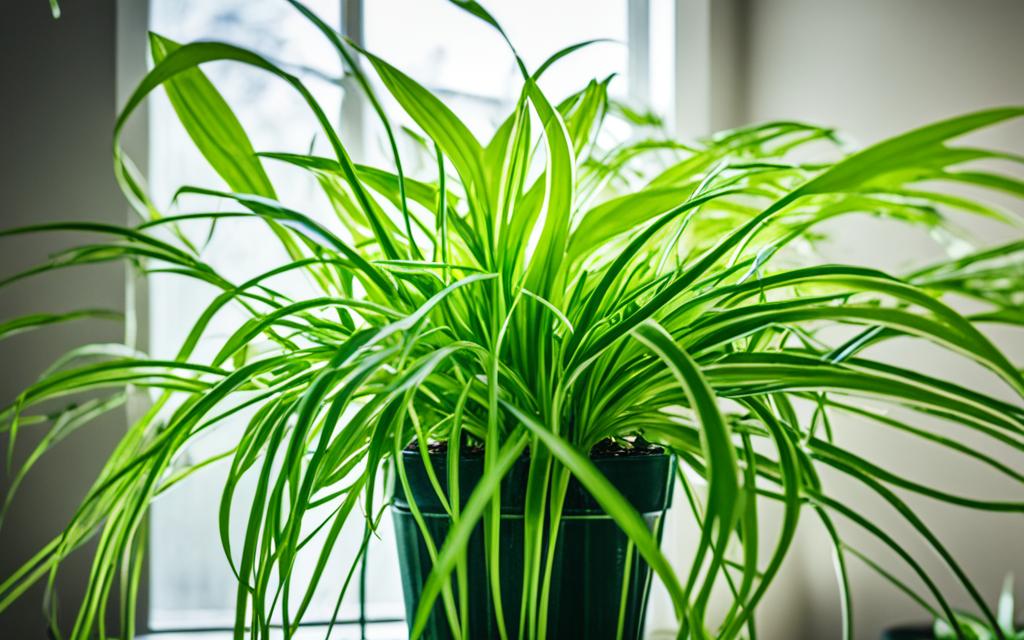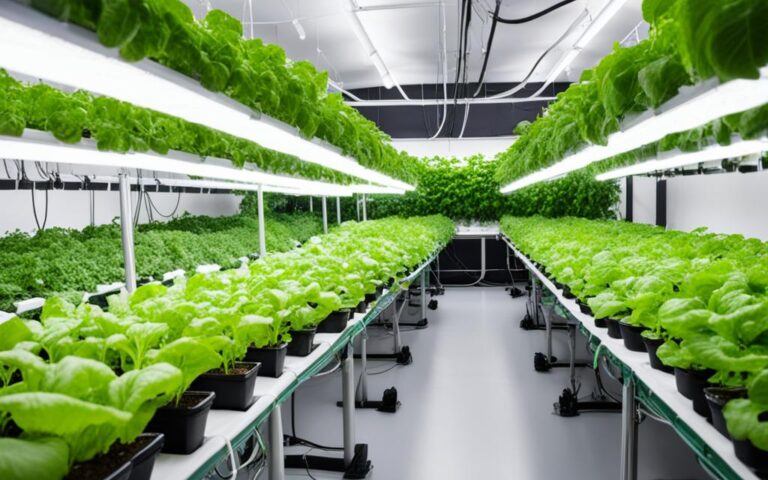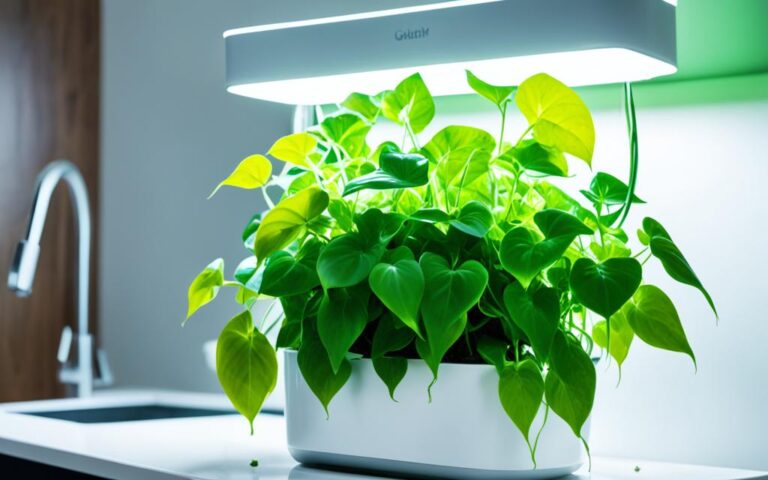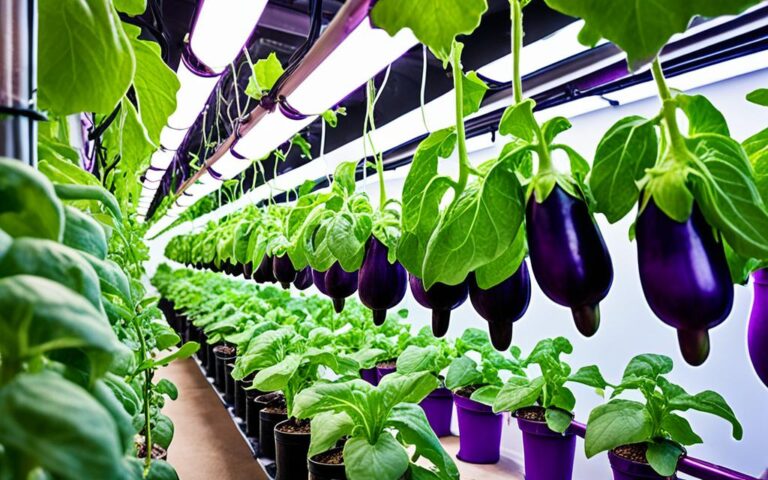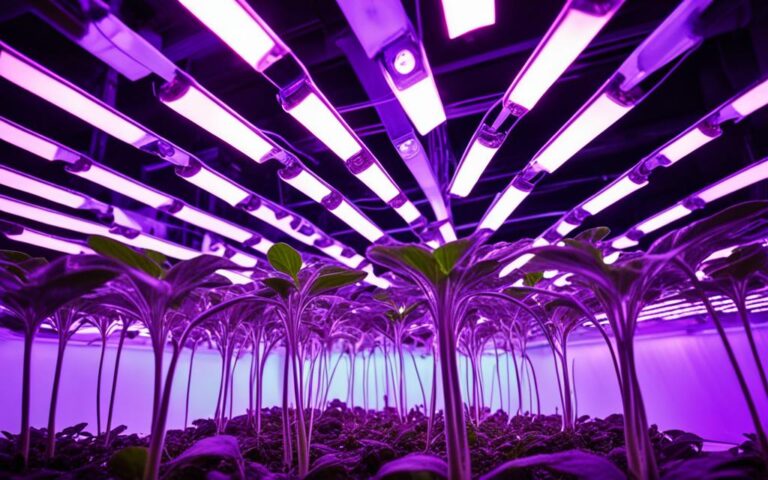Hydroponic Spider Plant Care & Growth Tips
Did you know a single spider plant can clean up to 87% of harmful air toxins? It’s a top choice for homes and offices in the U.S. But, these plants can do even better in a hydroponic setup. We’ll show you how to make them grow well and keep the air clean.
Key Takeaways
- Spider plants are great at cleaning the air, removing up to 87% of toxins.
- Hydroponics is perfect for spider plants to grow and thrive.
- Learn how to pick, spread, and care for hydroponic spider plants.
- See how spider plants work in vertical gardens and their part in NASA’s clean air study.
- Find fun ways to show off your hydroponic spider plants.
Introduction to Hydroponic Spider Plants
The Chlorophytum comosum, also known as the spider plant, is a popular houseplant. It’s loved for its long leaves and the way it makes “spiderettes” – baby plants that hang from its stems. These plants do well in many places, including hydroponic setups. Hydroponics gives them special benefits over growing in soil.
Overview of Spider Plant Characteristics
Spider plants grow quickly and need little care. They clean the air and look great with their green leaves that curve down. They can make new plants easily by producing offsets, or spiderettes.
Benefits of Growing Spider Plants Hydroponically
- Improved air purification: Hydroponic spider plants are great at removing toxins like formaldehyde and benzene from the air.
- Faster growth rates: Hydroponics gives plants the right amount of nutrients and water, making them grow faster and healthier.
- Reduced maintenance: These systems need less watering and feeding than soil-based plants, perfect for those who are busy.
Hydroponic technology lets spider plant lovers get the most out of these plants. They get better air quality, easy growth, and less work in caring for them.
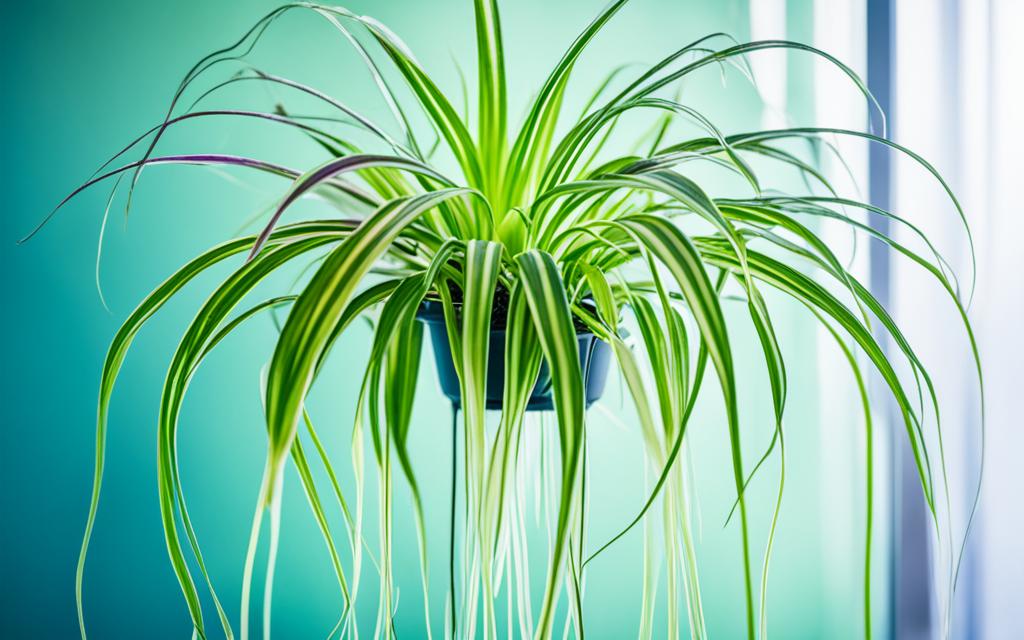
Selecting and Preparing Spider Plant Spiderettes
Starting with the right spider plant spiderettes is key for hydroponic success. Look for ones that are strong, have healthy leaves, and show root growth. These healthy spider plant propagation choices will do well in your hydroponic setup.
Choosing Healthy Spiderettes for Propagation
When picking spider plant offsets, check for these traits:
- Sturdy, well-formed leaves without damage or discoloration
- Visible root development at the base of the spiderette
- A compact, centered growth habit with a strong connection to the mother plant
Properly Removing Spiderettes from the Mother Plant
To remove spider plant spiderettes correctly, use clean scissors or pruning shears. Cut as close to the base as you can. Be gentle with the spider plant propagation to avoid harming leaves or roots. Proper cutting spider plant offsets helps reduce stress and boosts the chance of success in your hydroponic system.
“The key to thriving hydroponic spider plants lies in choosing the right spiderettes and removing them with care.”
Setting Up the Hydroponic System
Growing spider plants hydroponically offers many options. You can choose from ebb and flow systems, nutrient film technique (NFT), or deep water culture (DWC). Each setup has its own benefits and needs. Looking into these types of hydroponic setups can help you pick the best one for your spider plant garden.
Different Types of Hydroponic Systems for Spider Plants
- Ebb and flow systems: This method floods the plant’s roots with nutrient-rich water, then drains it back into a reservoir.
- Nutrient film technique (NFT): Plants get a steady stream of nutrient solution over their roots in an NFT system.
- Deep water culture (DWC): Roots of plants are submerged in a nutrient-rich water solution, with air pumps adding oxygen.
No matter the hydroponic spider plant setup you pick, you’ll need some key parts for success:
- Growing container: A vessel to hold the plant and its growing media.
- Grow media: Materials like clay pebbles or hydroton that support the roots.
- Air pump: Adds oxygen to the roots.
- Nutrient solution: A special formula to feed the plant.
- Appropriate lighting: The right light is key for the plant’s growth.
By picking and putting together these hydroponic system components, you can make a great hydroponic systems for spider plants. This will help your spider plants thrive.
Planting Spider Plant Spiderettes in Water
Starting your hydroponic journey with spider plants means planting the spiderettes in water first. This step is key for healthy roots and plants that grow well. We’ll cover how to prepare the water and container, and where to put the spiderettes for the best growth.
Preparing the Water and Container
Start with clean, dechlorinated water for your hydroponic setup. The water’s quality is crucial for your spider plant hydroponic water. Make sure the pH level is right to help your plants absorb nutrients well and stay healthy.
Then, pick a good hydroponic container setup for your spider plant spiderettes. The container should be clean, the right size, and have good drainage to avoid waterlogging. This setup helps your plants grow well.
Positioning the Spiderettes for Optimal Root Growth
Put the spider plant spiderette placement in the hydroponic container carefully. Make sure only the roots are in the water, and the leaves are above it. This way, you help your plants grow strong roots without leaf rot or fungus.
By doing these steps, you’re setting your spider plant hydroponic water up for success. You’re making a strong start for a great hydroponic journey.
Providing the Right Growing Conditions
For hydroponic spider plants, the right lighting is key for growth. They love bright, indirect light, perfect for hydroponics. Here are some tips to meet their spider plant light needs:
Optimal Light for Hydroponic Spider Plants
These plants need lots of natural light but should avoid direct sunlight to prevent damage. If sunlight is scarce, use hydroponic lighting like LED or fluorescent lights. Aim for a light level of 6,000-10,000 lux (about 600-1,000 foot-candles) for the best growth.
Keep your hydroponic spider plants on a regular light schedule. Aim for 12-14 hours of light each day. This helps with photosynthesis and keeps the plants healthy and growing well.
| Lighting Requirement | Recommendation |
|---|---|
| Light Intensity | 6,000-10,000 lux (600-1,000 foot-candles) |
| Lighting Schedule | 12-14 hours per day |
With the right spider plant light needs and hydroponic lighting, your plants will do great indoors.
Nutrient Management for Hydroponic Spider Plants
Keeping the right nutrient levels is key for hydroponic spider plants to do well. Nutrients like nitrogen, phosphorus, and potassium are crucial for healthy leaves, strong roots, and overall health. Regular checks and tweaks to the nutrient solution help your hydroponic spider plants get what they need.
Essential Nutrients and Their Roles
The essential elements for growth in hydroponic spider plants are:
- Nitrogen (N): Helps make leaves green and plants strong.
- Phosphorus (P): Helps roots grow and plants to thrive.
- Potassium (K): Makes plants tough and able to handle stress.
- Calcium (Ca): Builds strong cell walls and plant structure.
- Magnesium (Mg): Important for making chlorophyll and photosynthesis.
Monitoring and Adjusting pH and EC Levels
It’s also vital to keep an eye on the pH and electrical conductivity (EC) of the hydroponic solution. Aim for a pH between 6.0 and 7.2. Check the EC levels to make sure the plants get the right amount of nutrients.
| Parameter | Optimal Range | Importance |
|---|---|---|
| pH | 6.0 – 7.2 | Helps plants absorb nutrients well |
| EC (Electrical Conductivity) | 1.2 – 2.4 mS/cm | Shows how much nutrients are in the solution |
By watching and adjusting these critical parameters, you can keep your hydroponic spider plants healthy. This ensures they get the optimal nutrient requirements they need.
Maintaining a Healthy Hydroponic Environment
Keeping your hydroponic environment healthy is key for your spider plants to grow well. It’s important to change the water often and clean the system well.
Water Changes for Spider Plants
Changing the water in your hydroponic system often is crucial. It stops bacteria, algae, and mineral buildup that can hurt your plants. Try to change the water every few days to keep nutrients at the right level and provide a clean, oxygen-rich space for your plants.
Cleaning the Hydroponic System
Along with water changes, cleaning your hydroponic setup is a must. This includes the grow tray, reservoir, tubing, and other parts. Use a gentle, safe cleaner to remove any dirt or buildup. A clean system helps with hydroponic system maintenance and makes water changes for spider plants work better.
| Task | Frequency |
|---|---|
| Water changes | Every 2-3 days |
| Cleaning the hydroponic setup | Weekly or bi-weekly |
Regularly keeping the water clean and cleaning hydroponic setups helps. This creates a healthy, thriving space for your hydroponic spider plants to grow and flourish.
Common Issues and Troubleshooting
Keeping a hydroponic spider plant healthy is rewarding but comes with challenges. Growers face issues like nutrient deficiencies and pests and diseases. It’s important to stay alert to keep your plants thriving.
Identifying and Addressing Nutrient Deficiencies
Nutrient deficiencies are common in hydroponic spider plants. They show up as yellow leaves, slow growth, or color changes. Watch your plants and the nutrient solution closely to spot and fix any imbalances.
Adjust the levels of nutrients like nitrogen, phosphorus, and potassium. This will help your plants grow well again.
Dealing with Pests and Diseases in Hydroponic Systems
Hydroponic systems can get pests and diseases if not kept clean. Watch out for pests like spider mites, aphids, or root rot. Clean your system often and check for early signs of trouble.
Act fast if you find any issues to keep your plants healthy.
| Common Pests in Hydroponic Spider Plants | Symptoms | Management Strategies |
|---|---|---|
| Spider Mites | Webbing, stippling, or discoloration on leaves | Regular system cleaning, use of natural predators |
| Aphids | Curled, discolored leaves, sticky residue | Insecticidal soap, introduction of beneficial insects |
| Root Rot | Wilting, yellowing, or discolored roots | Improving drainage, use of beneficial bacteria |
By being vigilant and acting early, you can beat these common problems. This keeps your hydroponic spider plants healthy and full of life.
Hydroponic Spider Plant Care Tips
Keeping a hydroponic spider plant healthy means watching it closely and making changes when needed. By paying attention to how your plants grow, you can help them stay healthy and strong in your hydroponic setup.
Monitoring Plant Growth and Making Adjustments
Watch the color, shape, and health of your hydroponic spider plants. They should have bright green leaves and strong roots. If you see any changes, it’s time to check and fix your hydroponic system.
- Monitor leaf color: Leaves that are turning yellow or pale may indicate a nutrient deficiency or excess.
- Check root development: Healthy roots should be white and grow actively. Browning or slowing root growth may signal an issue with the water quality or nutrient levels.
- Assess overall plant vigor: Observe the plant’s overall growth rate, leaf size, and new leaf production. Slower growth or wilting may require adjustments to light, temperature, or nutrient supply.
Based on what you see, make changes to your hydroponic system. This could mean changing the nutrient solution, adjusting the lighting, or tweaking the water pH or EC levels. Keeping a close watch on your spider plants and fixing problems quickly is crucial for their health and growth in a hydroponic setup.
“Consistent monitoring and proactive adjustments are the keys to success in hydroponic spider plant cultivation.”
Transplanting Hydroponic Spider Plants to Soil
When your hydroponic spider plants grow well, it might be time to move them to soil. This move needs careful planning and doing to make sure your plants adjust well. Let’s look at how to move hydroponic spider plants to soil.
Once your spider plants have strong roots in the hydroponic setup, they’re ready to be moved. Carefully take the plants out, keeping as much root as you can. This makes it easier for them to settle in soil.
Get a potting mix that drains well and suits spider plants. Transitioning hydroponic spider plants to soil means they need a mix that drains well and holds nutrients. Choose a good potting mix for indoor plants or make your own with compost, perlite, and vermiculite.
When planting in soil, put the spider plant spiderettes in carefully. Make sure the roots aren’t packed in too tight or buried too deep. Water the soil well to help the plants get settled. Give them indirect, bright light and check the soil often, watering as needed.
- Gently remove the spider plants from the hydroponic system, preserving the root structure.
- Prepare a well-draining potting mix with the appropriate soil requirements for spider plants.
- Plant the spiderettes in the soil, taking care not to overcrowd or bury the roots too deeply.
- Water the soil thoroughly and provide indirect, bright light to help the plants acclimate.
- Monitor soil moisture and make adjustments to watering as needed.
By following these steps, you can move your hydroponic spider plants to soil successfully. This lets them keep thriving and clean the air in your home or office.
Air Purification Benefits of Spider Plants
Spider plants are not just pretty; they’re also superheroes for clean air. A NASA study found them to be top-notch at removing toxins like formaldehyde and benzene from indoor air. Adding hydroponic spider plants to your space means cleaner, healthier air and better indoor air quality.
NASA Clean Air Study and Spider Plants
In the late 1980s, NASA studied how houseplants could clean the air. They found spider plants were great at taking out formaldehyde and benzene. Many studies since then have backed up these results, making spider plants known as top air purifiers.
“Spider plants are one of the best air-purifying plants, capable of removing up to 90% of harmful toxins from the air within 24 hours.”
Hydroponic spider plants can do well indoors and keep filtering the air. They’re a simple way to make indoor air cleaner. Whether at home, work, or any other space, these plants help create a healthier environment.
Creative Ideas for Displaying Hydroponic Spider Plants
Hydroponic spider plants are versatile and can brighten up any indoor space. They can turn living rooms and offices into green havens with their lush foliage. Adding hydroponic spider plant displays to vertical gardens is a creative idea.
Vertical Gardening with Spider Plants
Vertical gardens, or living walls, are perfect for showing off hydroponic spider plants. You can hang them from ceilings, mount them on walls, or have them stand alone. This way, you use space wisely and create a beautiful indoor plant arrangement.
- Hanging baskets: Suspend cascading spider plants in stylish hanging baskets to draw the eye upward and create a lush, living focal point.
- Wall-mounted systems: Utilize wall-mounted hydroponic systems to arrange your spider plants in a visually captivating display, adding a touch of greenery to any room.
- Freestanding towers: Vertical gardening towers provide a versatile platform to showcase your spider plants, allowing you to create a self-contained, low-maintenance indoor garden.
Adding hydroponic spider plant displays to your vertical garden can change any space into a lively, air-purifying oasis. These plants are not only beautiful but also easy to care for.
“Vertical gardens offer a unique and visually striking way to integrate spider plants into your living or work environment, creating an eye-catching display that also improves indoor air quality.”
Propagating and Multiplying Spider Plants
Spider plants are known for their fast growth and ability to produce many “spiderettes” or baby plants. By propagating these spiderettes, you can easily grow more of your hydroponic spider plants. This method lets you share plants with friends, add new ones to your home, or even start a small business.
Dividing and Transplanting Spider Plant Offsets
Dividing offsets or spiderettes from the mother plant is a simple way to propagate spider plants. Here’s how:
- Take the spiderette from the mother plant, making sure it has its roots.
- Put the spiderette in a potting mix that drains well, in a new pot or directly in the soil.
- Water it well and put it in a spot with bright, indirect light.
- Watch the plant closely and keep the soil moist but not too wet.
Propagating Spider Plants in Water
Rooting spiderettes in water is another great way to grow more spider plants. This method is perfect for those wanting to increase their spider plant propagation or share hydroponic spider plant offsets.
- Remove a spiderette from the mother plant, making sure it has a short stem.
- Put the spiderette in a clean container filled with water, with the roots underwater.
- Place the container in a bright, indirect light spot and change the water every few days.
- Watch the spiderette as it grows roots. Once they are a few inches long, move it to a potting mix.
Learning how to multiply spider plants lets you build a thriving hydroponic garden. You can also share these hardy, air-cleaning plants with loved ones.
Conclusion
Hydroponic spider plants are a great choice for anyone wanting to add beauty and clean air to their space. This guide has shown you how to set up and care for these plants. You’ll learn how to create a thriving hydroponic system that improves your indoor air quality.
Spider plants are easy to care for and great at cleaning the air. This guide has given you the knowledge to start and keep a healthy hydroponic spider plant system. By following the care tips, you can make your space healthier and more lively.
With the right setup and care, your hydroponic spider plants will do well. They’ll give you lots of greenery, grow fast, and clean the air. Enjoy growing these tough and adaptable plants. Let them make your space more beautiful and improve your health.
